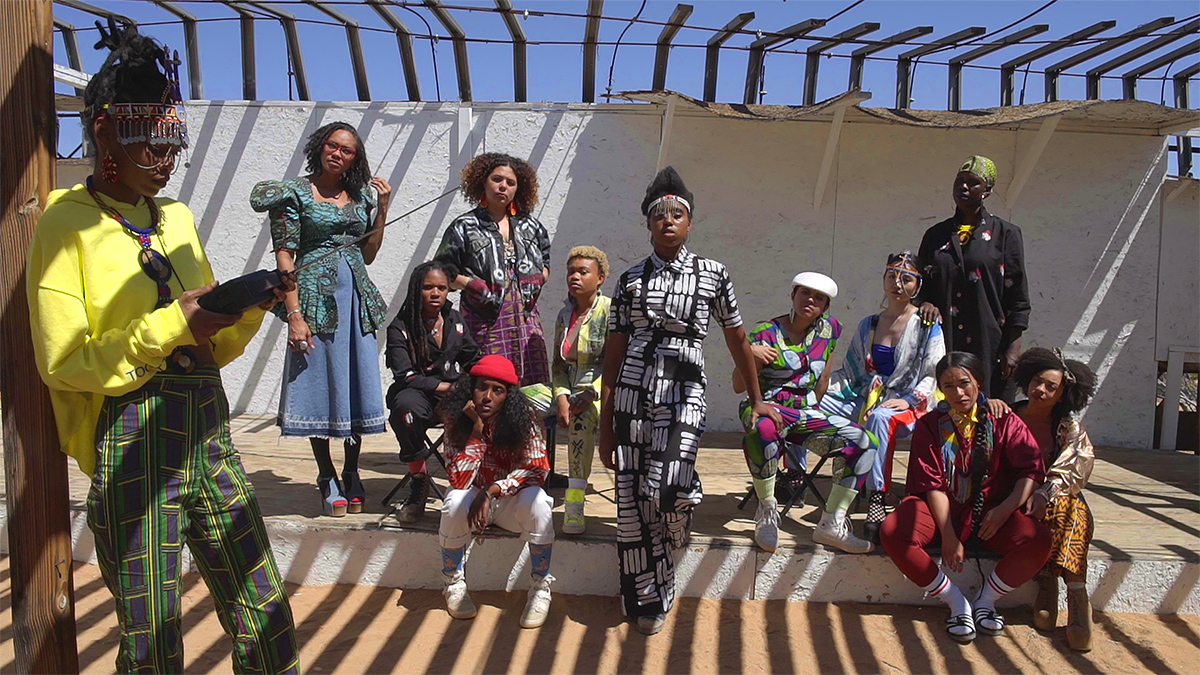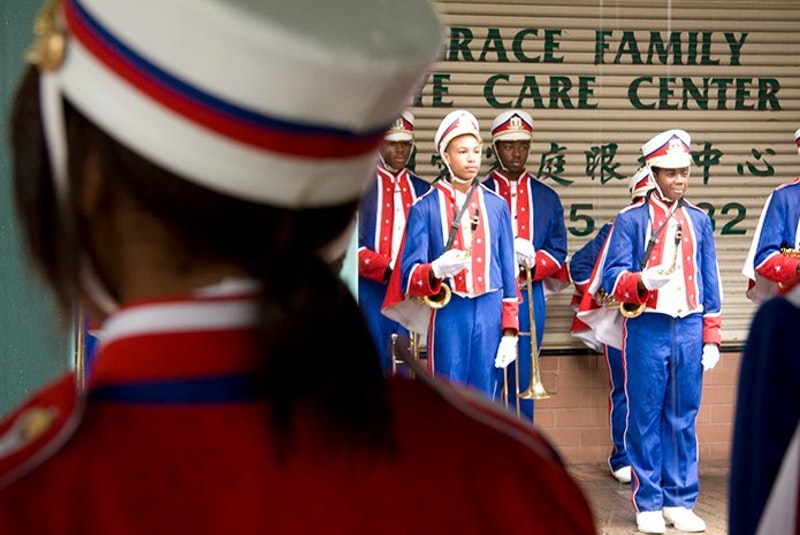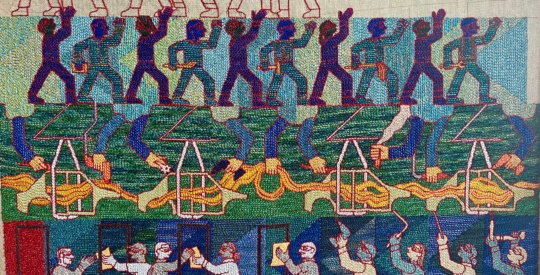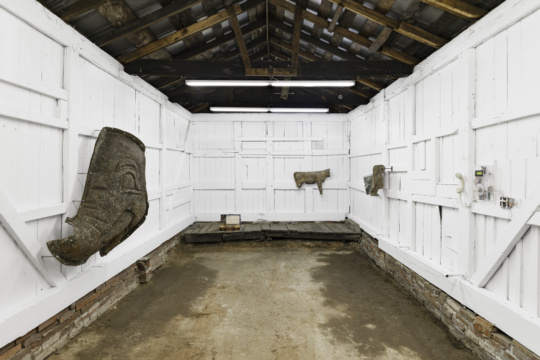
Los Angeles-based Cauleen Smith (b. 1967) is an multidisciplinary artist whose work employs elements of film, sculpture, installation, and sound. A California native, Smith recently returned to the Golden State after seven years in Chicago. Last year, the Institute of Contemporary Art, Philadelphia, organized a solo exhibition of her work, Give It or Leave It, which combined multi-channel video, found objects, and sound elements to explore four narratives tied to musician Alice Coltrane, religious activist Rebecca Cox Jackson, artist Noah Purifoy, and photographer Bill Ray. In addition to solo exhibitions at The Art Institute of Chicago and The Kitchen, Smith was featured in both the Whitney Biennial in New York and Prospect 4 in New Orleans in 2017. In advance of the opening of Give It or Leave It at the Markel Center at the VCU Institute for Contemporary Art in Richmond on February 16, I spoke with Smith about her recent work. Our conversation was conducted in writing in January 2019 and has been edited for publication.
Amanda Dalla Villa Adams: When did you decide to pursue a multidisciplinary approach to art-making?
Cauleen Smith: The interdisciplinary nature of filmmaking has always kept me invested in it as a discipline. A film director, regardless of genre, must consider everything inside of the frame, from the figure to the texture of the walls, to the choreography of action, to ambient sound, to the color of light to rhythm and pacing. Each attempt at making a moving image is a new opportunity to think about all these things and what they might mean working in concert. When I’m working in an art space, I approach it the same as when I make a film, except that all the different disciplines get atomized into discrete materials and objects.

ADVA: Research is an important part of your practice: for Give It or Leave It, for example, you’ve researched the lives of figures including Sun Ra, Alice Coltrane, Noah Purifoy, and Rebecca Cox Jackson. How do research methods inform your work? How do you choose who and what to research?
CS: Brilliant humans of the past have left us breadcrumbs so that we can build the futures we want and need. One of the things I love about contemporary art is the way it allows people who are earnestly concerned with the world to try to understand it through the idiosyncratic explorations of artists. If I am interested in a person or a place, I don’t have to make a factual travelogue documentary or biopic: I can use the things that person made to make new things that connect us to our pasts and speculate about possible futures—about who we want to be, and even what we want to leave behind.
Whenever I make work, I am imagining a future audience, an audience that does not exist. And what I’ve learned by studying the work of individuals like Sun Ra and Alice Coltrane is that they too understood the ways in which they were building future worlds. They were devoted to mentoring young people. They built things and shared them. They are models, not just for what to make but how to live.
When I’m researching a person or a place, I feel that I am having a conversation with their work, and like any good conversation, something emerges that you did not know or did not expect. In terms of deciding what to research, I guess curiosity, affinity, and affection are the first things, and then as I learn stuff, I start discovering interesting pockets of knowledge that feel generative, and then I pursue them. I also think about accountability and the difference between consuming a culture versus practicing a culture. Sometimes an interest sits around for years before I develop it into a project—the Shaker Gift Drawings, for example, I had no idea even why I liked them. It wasn’t until I read Alice Coltrane’s books and she described things that were in these drawings that I decided to formalize my relationship to that material and make it part of my work. And many things just remain stuff I like, stuff I appreciate, and never bloom into artworks or films.
ADVA: Can you also talk about your interest in jazz and music, especially as it relates to your video Space is the Place (A March for Sun Ra) (2011) and performance works?

CS: Ah, well, another word for jazz music is creative music, and this term was coined in Chicago by the Association for the Advancement of Creative Musicians in the middle of the twentieth century by musicians who made their compositions through an improvisational process. In the dominant cultural understanding of the word improvise, people generally think of making things up, winging it, compensating for lack or preparation or for something going wrong. But in Black culture, improvisation is a high art discipline and signifies high achievement or mastery (forgive the gender bias) over one’s discipline. You cannot improvise or create in real time unless you have a very deep understanding of your craft. Film is a craft in which it is very difficult to improvise. But I’ve always wanted my work to have the power and the innovation of the great improvisers of the twentieth century, so how do we do that? I decided to try out creating situations and conditions in which a film would be made. So A March for Sun Ra was designed to be a carefully planned film shoot around a flash mob with five camera operators who then had to improvise in order to gather materials that I would then edit into a film. It worked. I keep trying to expand on this way of making. One of my greatest experiences as a filmmaker was watching the footage from five operators and seeing what they brought me—seeing what they saw, seeing how they responded to gorgeous, disciplined young people performing their hearts out in the rain. I was like, “Wow! Look at that shot…and that shot!” I provided the event, set up conditions and parameters, and then selected excellent collaborators. In this way, I am able to generate a kind of improvisational dynamism.
ADVA: You have said, “I actually think that art might be the only thing at this point. Not protesting, and not politics, but art may be the only thing that could actually create conversation and dialogue or reconciliation or mediation. Because politics has just completely failed us. What I hope my work is capable of is for individuals, it’s for just any one person. If there’s just enough of an opening in them that they think about themselves or the world or just think, and not even think differently, but just think for a moment. Just contemplate. Just open up a little bit, then I’ve done my job.”
Do you consider your work to be a form of activism?
CS: My understanding of activism is that it is tied to political concerns, tied to drawing attention to policy problems and attempting to use protest and grassroots organizing to create pressures that make policy changes that change political tides. Activism is—to my understanding—about the masses, it’s about creating mass consensus, it’s about influencing power. My work does none of those things. My work is connected to things that happen in the world, but politics, like art, is a discipline and a practice. I think if people better understood that, they would better understand their roles in both art and politics. As a citizen I have deeply vested concerns about political change and about how to make that happen. As an artist, I am dealing with individuals who are looking to learn something, experience something. I’m not trying to bludgeon people into conforming to an ideology, I’m trying to open them to their own hearts and minds and the hearts and minds of those around them, right next to them in the adjacent car, or at the grocery store.

ADVA: Ritual, religion, and spirituality seem important in Give It or Leave It, which weaves together images of the Shaker community, Simon Rodia’s construction of Watts Towers, and Alice Coltrane’s spiritual transformation, among others. How do you think a religious impulse might or might not inform your recent work?
CS: Religion is the organization of spiritual practices and beliefs into cultural, political, and economic power bases. The work I make, regardless of the individuals I might research, has nothing to do with religion, but it does, like most art, depend greatly on the spirit.
ADVA: What are you reading right now or intending to read in the year ahead?
CS: I’m trying to learn as much as I can about contemporary Indigenous life culture and practices in the United States and Canada. My Native American brothers and sisters are marginalized, silenced, and rendered invisible in contemporary life. America has never reckoned with the ways in which the founding of this country was dependent upon the genocide of Indigenous peoples. This country refuses to tell itself the truth about this. We need some truth and reconciliation. We need some serious atonement. And I personally need to not be so ignorant about the people whose land sustains me.
Even more urgent for me is the fact that the languages and cultures of Indigenous peoples are have been systematically undermined. I’ve been trying to learn about Native American restorative justice practices. I’ve been thinking about the ways in which the language one speaks determines one’s understanding of the world. So in English about seventy percent of the words in our vocabulary are for people, places, and things. But in Anishinaabe languages, it’s my understanding (and I’m just still learning) that about seventy percent of words refer to beings. So water is a being, trees are beings, grasses are referred to as a being. Can you imagine our country if instead of eradicating this world view, we had studied it, incorporated it, and embraced it? Can you imagine? So that’s what I’m thinking about now. Imagining a country in which we are able to recognize the consciousness and life-force of everything around you, people, places, things all alive and all worthy of respect and consideration and love.
Cauleen Smith’s solo exhibition Give It or Leave It is on view at the Markel Center at the VCU Institute for Contemporary Art in Richmond from February 16 through May 5, 2019.




